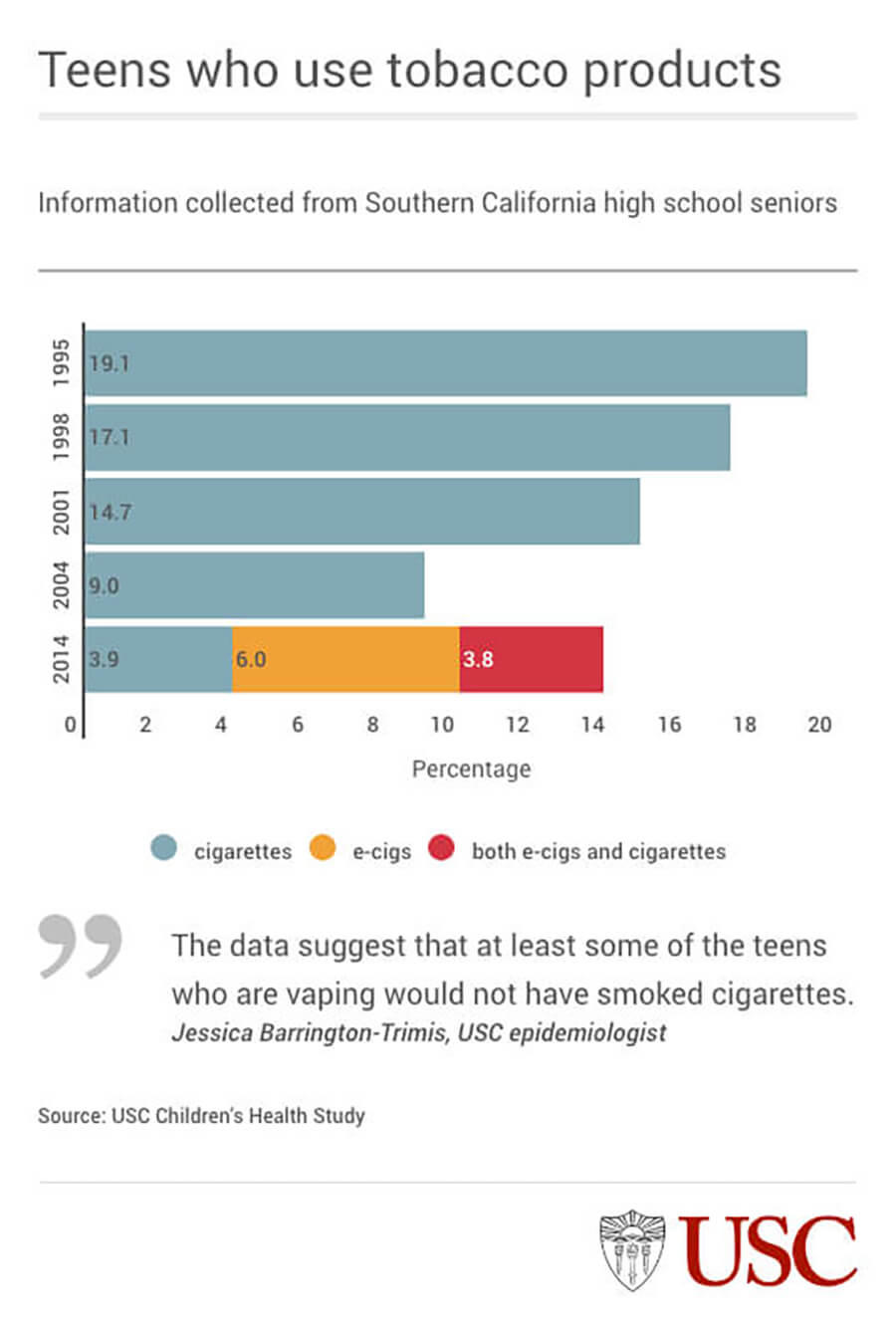Adolescents Who Wouldn’t Have Smoked May Be Drawn to E-Cigarettes
, by Daryl McGrath
Some adolescents who otherwise would never have smoked are using e-cigarettes, according to a study published July 11 in the journal Pediatrics. The findings suggest that adolescents are not just using e-cigarettes as a substitute for conventional cigarettes but that e-cigarettes are attracting new users to tobacco products.
E-cigarettes are electronic devices that create an aerosol by heating a liquid solution that often contains nicotine and flavorings, as well as other chemicals. They allow users to simulate smoking conventional cigarettes by inhaling the aerosol, which mimics combustible cigarette smoking. The Food and Drug Administration recently finalized a rule extending its regulation of tobacco products to include e-cigarettes. The rule went into effect this week.
The new findings come from the Children’s Health Study (CHS), which includes periodic surveys that assess smoking behavior among high school juniors and seniors in southern California.
Although use of conventional cigarettes in this population has declined steadily over the past two decades, the study showed an increase in the percentage of students who reported using cigarettes and/or e-cigarettes in 2014 (the most recent year data were collected) compared with the percentage of students using cigarettes in 2004. This increase in overall use of tobacco products threatens to reverse the downward trend of smoking among adolescents in southern California, the researchers suggested.
Two Decades of Declining Tobacco Use
Researchers from the USC Keck School of Medicine have been conducting the CHS, a longitudinal prospective cohort study of the effects of air pollution on schoolchildren in southern California, since 1992. As part of the study, they have surveyed 11th- and 12th-grade students at high schools in southern California about their use of cigarettes at different time periods, starting in 1994 and most recently in 2014. A total of 5,490 students have reported their history of cigarette use in individually administered questionnaires.
The study has documented a two-decades-long decline in cigarette smoking among adolescents in the area. In 1994, 19.1% of 12th-grade students reported current cigarette use. By 2004, the prevalence of current cigarette use among 12th graders had dropped to 9%. Data collected in 2014 show that the drop in current cigarette use has continued, with only 7.8% of 12th-grade students reporting current cigarette smoking.
E-cigarettes Reverse the Trend
However, the researchers found that use of cigarettes and e-cigarettes combined has increased among high school juniors and seniors since the 2007 introduction of e-cigarettes in the United States. In 2014, 13.7% of 12th-grade students in the study reported current use of cigarettes and/or e-cigarettes, a prevalence only slightly less than the current use of cigarettes that was reported in 2001 (14.7%) and much higher than current cigarette smoking reported in 2004 (9%). This increased prevalence suggests that e-cigarettes are being used by adolescents who likely would not have initiated smoking conventional cigarettes, they explained.
“The combined e-cigarette and cigarette use in 2014 far exceeded what we would have expected if teens were simply substituting cigarettes with e-cigarettes. The data suggest that at least some of the teens who are [using e-cigarettes] would not have smoked cigarettes,” lead author Jessica L. Barrington-Trimis, Ph.D., of the University of Southern California (USC), said in a news release.
Known and Unknown Harms
Although e-cigarettes do not carry the same dangers as conventional tobacco products, e-cigarette aerosol contains a number of harmful and potentially harmful chemicals as well as possible dangers that are not yet understood, the authors noted.
Nicotine is often included in the liquid used in e-cigarettes. The risk of nicotine addiction associated with e-cigarette use makes it likely that e-cigarettes could serve as a gateway device to conventional tobacco smoking, the authors contend, and some research already supports this hypothesis. (See the sidebar below.)
Another recent study, published in Pediatrics by the same USC research team, suggests that e-cigarette use may increase the likelihood of cigarette smoking initiation sixfold. Following up on data collected in 2014 from the CHS, the researchers contacted all 213 participants in the study who had never smoked conventional cigarettes but did use e-cigarettes and 213 randomly selected, matched students who had never smoked or used e-cigarettes; 146 and 152 respondents from each respective group provided complete data on use of combustible tobacco products.
After an average of 16 months, more than 40% of the e-cigarette users had initiated smoking of conventional cigarettes or other combustible tobacco products, compared with 10.5% of students who had not reported e-cigarette use in 2014. “These findings suggest that e-cigarette use may promote smoking during the transition to adulthood, even in those considered to be at lower risk because of personal or environmental factors,” the researchers wrote.
"The use of e-cigarettes by youth is a serious concern,” explained Elizabeth Ginexi, Ph.D., of NCI's Tobacco Control Research Branch, who was not involved in the study. "Research has revealed that nicotine exposure during adolescence may have longer-term effects on the developing brain, including putting the adolescent at increased risk for addiction later in life.”
For adolescents who have never used other tobacco products, nicotine experimentation with e-cigarettes could lead to nicotine addiction, Dr. Barrington-Trimis said.
And other studies have suggested that e-cigarette use may normalize behaviors associated with cigarette smoking, such as seeing clouds of smoke in public or gathering in a common place to “vape,” which may make smoking initiation more likely.
Potential Solutions
In an accompanying editorial, Jonathan P. Winickoff, M.D., M.P.H., of the Massachusetts General Hospital Tobacco Research and Treatment Center, and Sarah E. Winickoff, a Brookline, MA, public school student, proposed a number of strategies to address e-cigarette use by high school students. They suggest implementing school-based initiatives that emphasize the potential harms of e-cigarettes, including addiction, inhalation of toxins, and increased likelihood of smoking.
They also recommended that health professionals screen their adolescent patients for e-cigarette use and educate them about the effects of nicotine on the developing brain. And they called for policy makers to extend current prohibitions on traditional tobacco sales to adolescents and young adults to the purchase of e-cigarettes, as well as prohibiting use of e-cigarettes anywhere cigarette smoking is currently prohibited.
“Moving beyond the documentation of e-cigarette use toward vigorously pursuing possible solutions [to prevent such use] could help many adolescents escape addiction to nicotine,” the editorialists wrote.
Implications for Public Health
A major strength of this study is its use of more than 20 years of data collected from five cohorts in the same southern California communities, Dr. Ginexi said. The cohorts were drawn from entire classrooms of students, giving the researchers large samples of ethnically diverse students who were representative of youth in the region during this time period.
The authors noted that more research is needed to determine whether current users of e-cigarettes in the study population who have not used traditional cigarettes continue to use e-cigarettes exclusively, go on to smoke combustible tobacco products, become users of both, or stop using tobacco products altogether.
“Although the adverse health effects of e-cigarettes may be less than those of cigarettes, the long-term consequences of e-cigarette use are not known because these products have been on the market for less than a decade,” they wrote.

